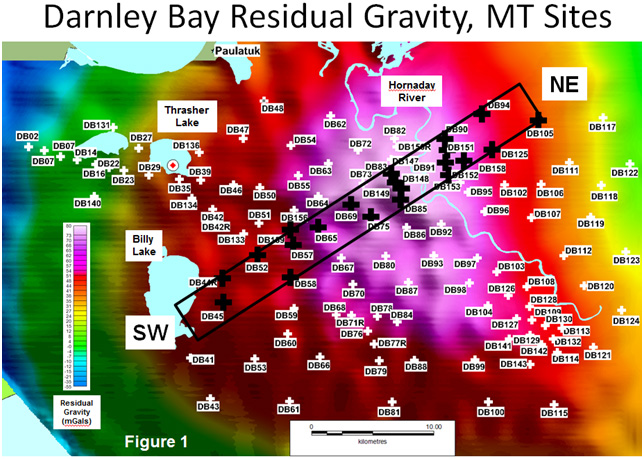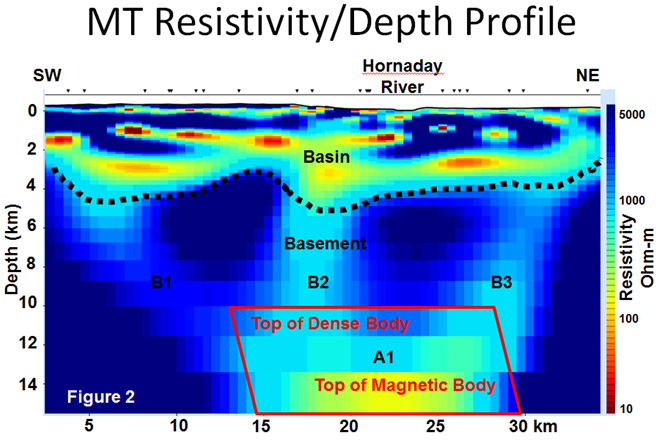Generation Mining’s Survey Images The Source Of Darnley Bay Anomaly
Toronto, Ontario – Sept 12, 2018 - Generation Mining Limited (CSE:GENM, the “Company”) is pleased to announce preliminary results from the summer Magnetotelluric (“MT”) program at its property near Paulatuk, Northwest Territories. The program has had the dual result of imaging the deep source of the Darnley Bay Anomaly and outlining a number of large discrete exploration targets nearer to the surface. The Darnley Bay property hosts the strongest known land-based gravity anomaly in the world, and is coincident with a similar-sized magnetic anomaly.
A total of 116 Magnetotelluric, deep searching geophysical soundings, were collected on the Darnley Bay property, over a 40 x 50 kilometre area, and blanketing the Darnley Bay geophysical anomaly. The program was completed by Quantec Geoscience Ltd., Toronto, with technical support provided by Stevens Geophysics Inc., Sudbury, Ontario.
“It is very exciting to finally image the source of this famous anomaly,” remarks Mr. Stevens, “What we are seeing at Darnley Bay are very similar geophysical characteristics to that of many of the great mineral deposit systems around the world.”
Figure 1 shows the colour contoured residual gravity data defining the Darnley Bay anomaly, and the location of the 116 MT soundings. The MT data was used to estimate the electrical resistivity structure of the Earth beneath each data station. Twenty-one of the MT soundings have been used to reconstruct the subsurface estimate of the resistivity structure to great depths. Figure 2 shows the MT resistivity/depth section recovered from these 21 sites. The image in Figure 2 is an estimate of the subsurface resistivity structure to 15 km depth, from the 2-dimensional (2D) MT model along a 35 km SW-NE profile and across the center of the Darnley Bay gravity anomaly (Figure 1). The results of this MT program confirm that the main source of the gravity and magnetic anomalies are coincident with a very large MT source at a 10 km to 13 km depth. The gravity signature is consistent with the response of a spatially large, 15 km x 15 km, and thick, >4 km, deep source body, that starts at depth of ~10 km. The magnetic signature is consistent with the presence of a large, 16 km x 16 km, > 4 km thick source, that begins at a depth of ~13 km. The estimated region of dense and magnetic materials, estimated from the simple ‘sill’ like model shown in Figure 2, has comparable amplitudes and source wavelengths to the observed data. The deep MT source is coincident with both of these signatures and has similar size and depth.
In addition, three low-resistivity ‘pathways’ (B1, B2, B3) extend from the deep MT source A1 to the bottom of the shallow basin structure (Figure2). The geological interpretation of the resistivity structure is that it shows a deep seated, single, large, conductive, intrusive body possibly extending to shallower depths along pathways B1, B2 and B3 and encountering the layered sedimentary basin rocks and the structures within it. This is the classic signature of a magmatic mineral system, similar to deep crustal resistivity structures that have been observed at other large scale intrusive systems (i.e. IOCG-Olympic Dam, see Heinson, G., Didana, Y., Soeffky, P., Thiel, S., & Wise, T. (2018). The crustal geophysical signature of a world-class magmatic mineral system. Scientific Reports, 8, 10608 http://doi.org/10.1038/s41598-018-29016-2).
Of greater importance to Generation Mining are a number of strong MT anomalies within 800-1200 metres of surface. These may reflect mineralized sources in the overlying sedimentary basin with origins related to the deep intrusion and connected through the pathways. Drilling is needed to confirm the nature of these MT anomalies.


Magnetotellurics is a natural source, low environmental impact, geophysical method of imaging the earth’s subsurface by measuring at the earth’s surface natural variations of electrical and magnetic fields generated by the passage of the magnetic and electromagnetic energy from cosmic radiation, sunspot activity and terrestrial thunderstorm activity. The method allows for the deep imaging of the structure and composition of the earth’s subsurface to depths greater than conventional airborne and ground geophysical exploration surveys. Since the 1990s, MT has been successfully used to locate deep conductive mineral deposits at depths exceeding 1500 metres in the Sudbury nickel camp; base metal deposits in South America, the western cordillera of North America and in Precambrian Shield areas around the world. In the last 10 years, this technique has seen a number of improvements, particularly with the development of modern 2-D/3-D modelling. It is now routinely used in the oil industry to better define deep drilling targets, and to supplement or replace seismic in areas where seismic is not permitted for environmental reasons and/or provides poor resolution due to volcanic cover.
The property is held by Generation Mining under option from the Inuvialuit Regional Corporation, which holds certain back-in and other rights. The gravity anomaly on the property has been favorably compared by the Geological Survey of Canada (“GSC”) with other prominent gravity anomalies such as those at the prolific mining camps of Noril’sk in Russia and Sudbury Basin in Ontario. It is located near Paulatuk, Northwest Territories, on the Arctic coast. The Darnley Bay anomaly is larger and stronger than any of these comparatives by a wide margin, measuring 100 kilometres long north to south and about 60 kilometres wide. The GSC discovered the anomaly in 1969 and its source has never been explained before now.
Qualified Person
Kevin M. Stevens, P. Geo, is a “qualified person” for the purposes of National Instrument 43-101 - Standards of Disclosure for Mineral Properties and the Company’s Professional Consulting Geophysicist. He has prepared or supervised the preparation of the information contained in this news release.
About Generation Mining Limited
Generation Mining Limited is a base and precious metals exploration and development company with various property interests throughout Canada. Its primary business objective is to explore and further develop the Davidson Molybdenum project in British Columbia and its other mineral properties, and to continue to increase its portfolio of base and precious metal property assets through acquisitions.
For further information please contact:
Jamie Levy
President and Chief Executive Officer
(416) 640-2934
(416) 567-2440
[email protected]
Forward-Looking Information
This release includes certain statements that may be deemed “forward-looking statements”. All statements in this release, other than statements of historical facts, that address future production, reserve potential, exploration drilling, exploitation activities and events or developments that the Company expects are forward-looking statements. Although the Company believes the expectations expressed in such statements are based on reasonable assumptions, such statements are not guarantees of future performance and actual results or developments may differ materially from those in the statements. There are certain factors that could cause actual results to differ materially from those in forward-looking statements. These include market prices, exploitation and exploration successes, continued availability of capital and financing, and general economic, market or business conditions. Investors are cautioned that any such statements are not guarantees of future performance and actual results or developments may differ materially from those projected in the forward-looking statements. For more information on the Company, investors are encouraged to review the Company’s public filings at www.sedar.com. The Company disclaims any intention or obligation to update or revise any forward- looking statements, whether as a result of new information, future events or otherwise, other than as required by law.
